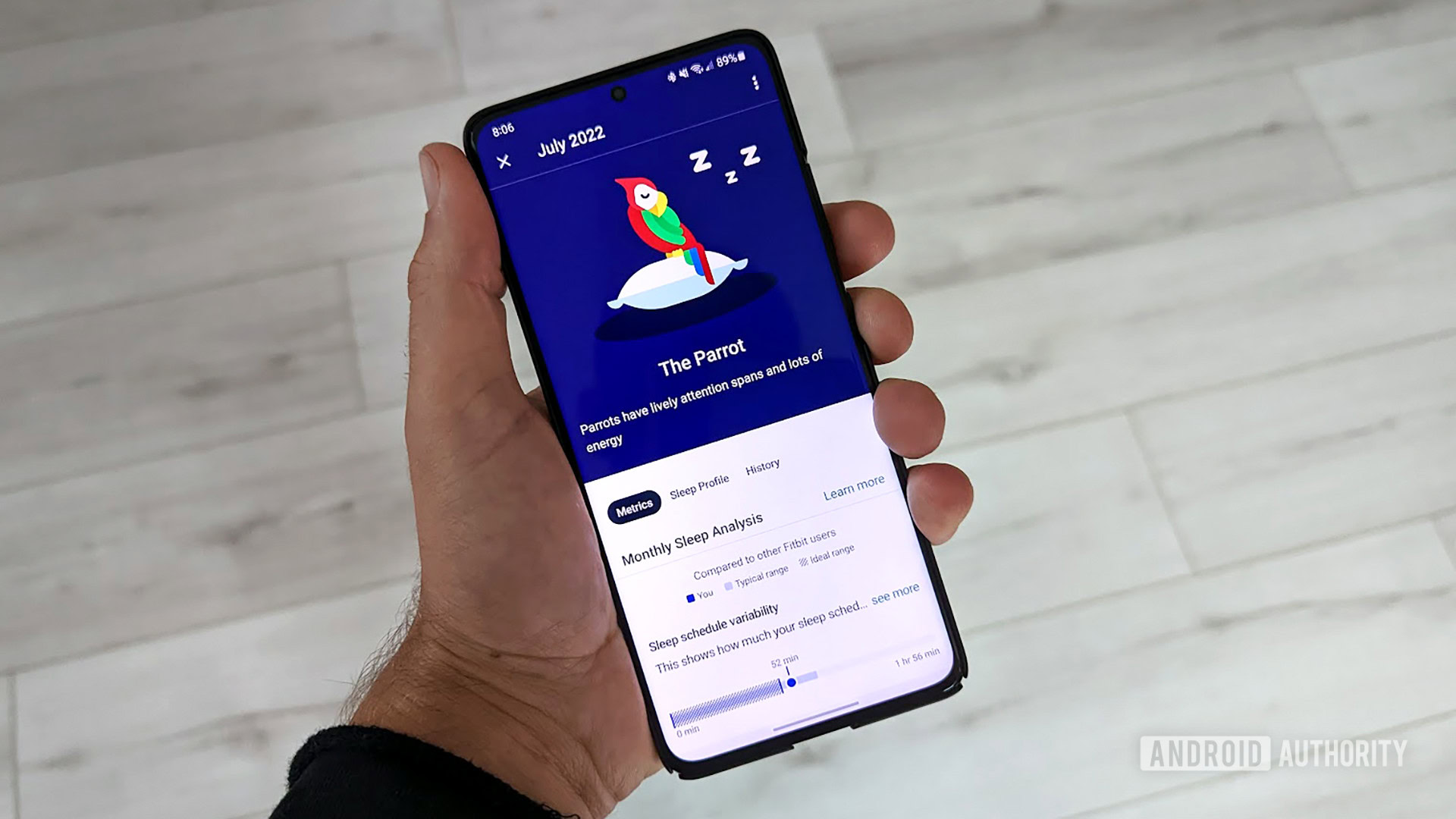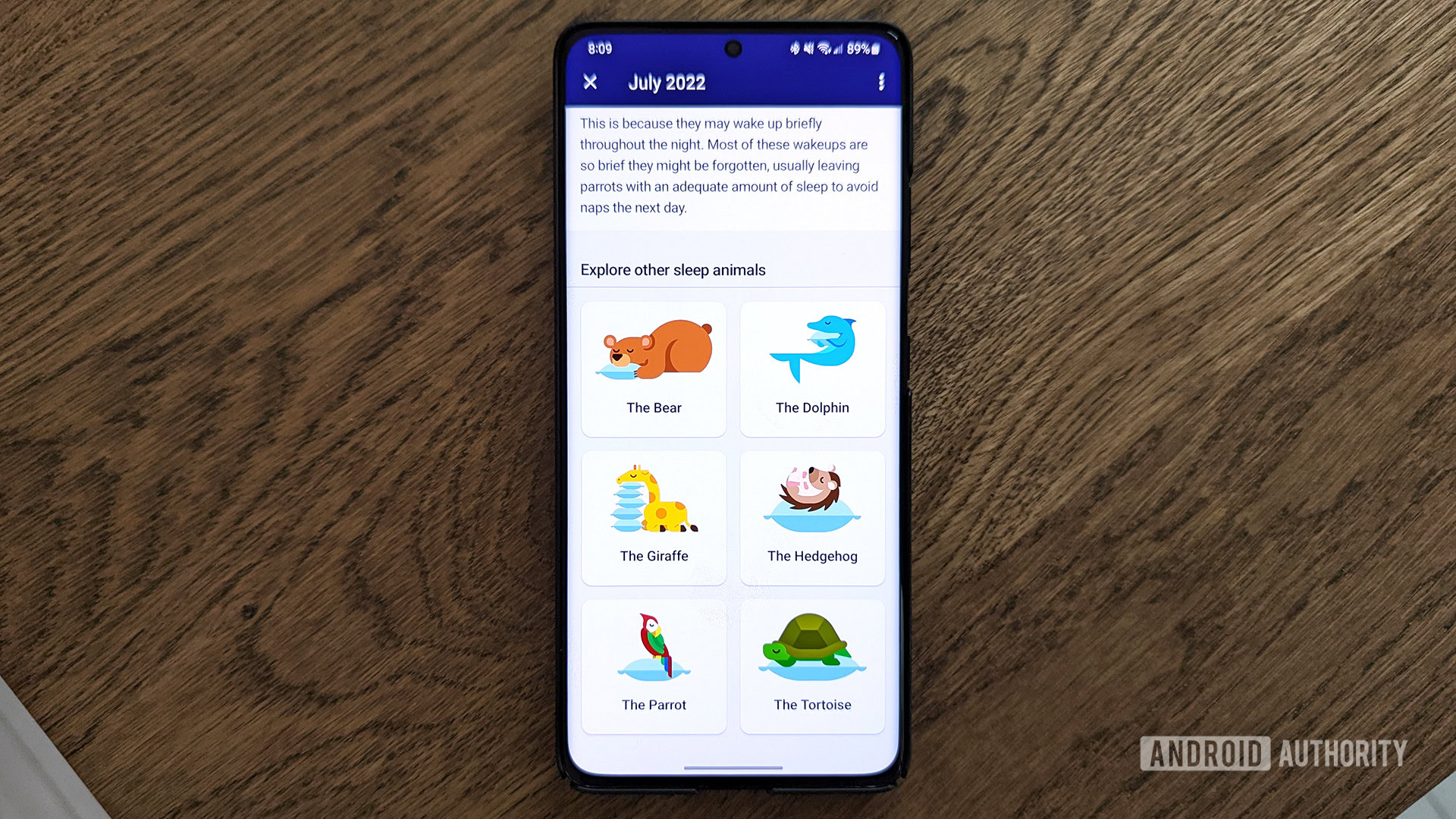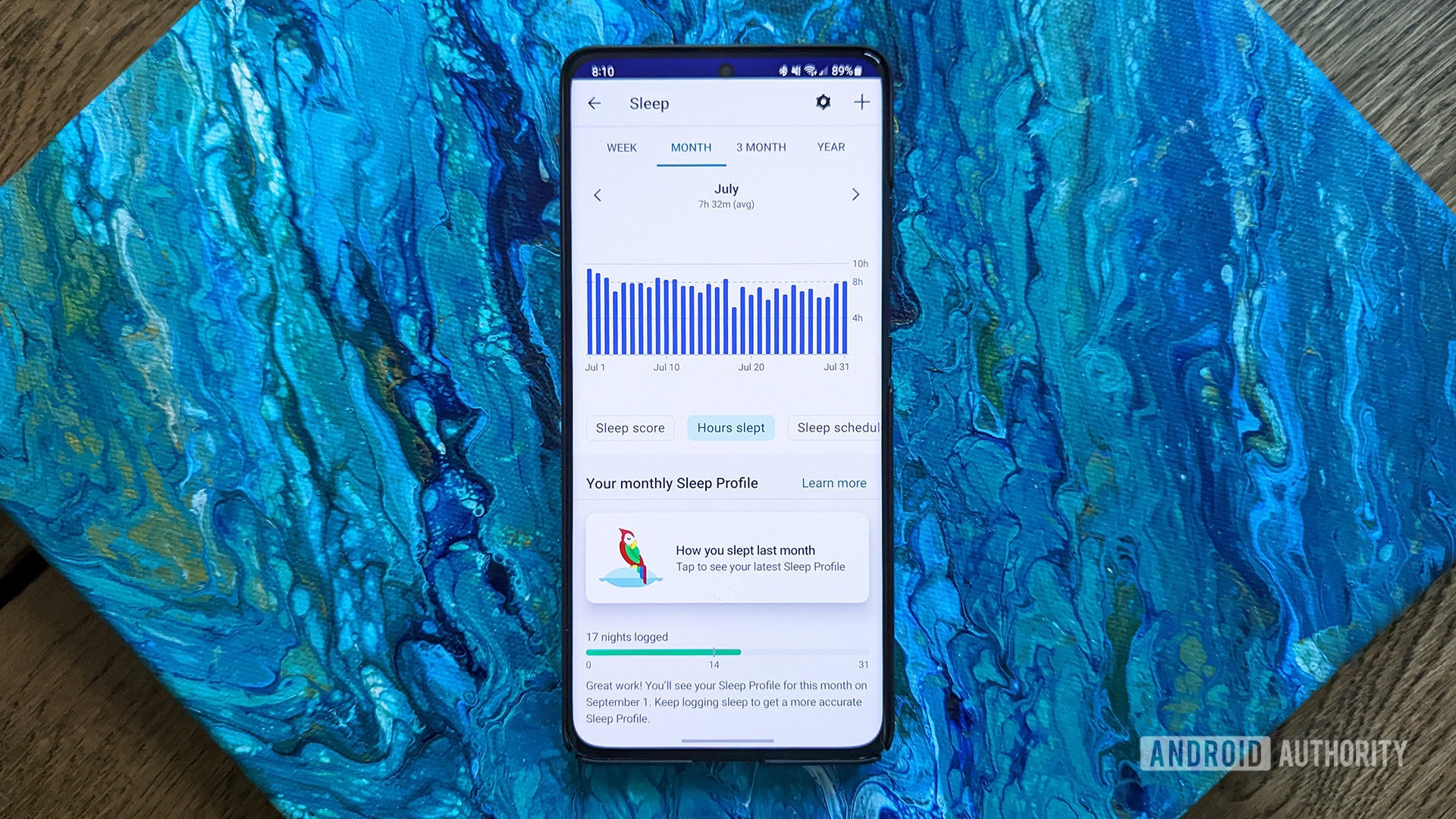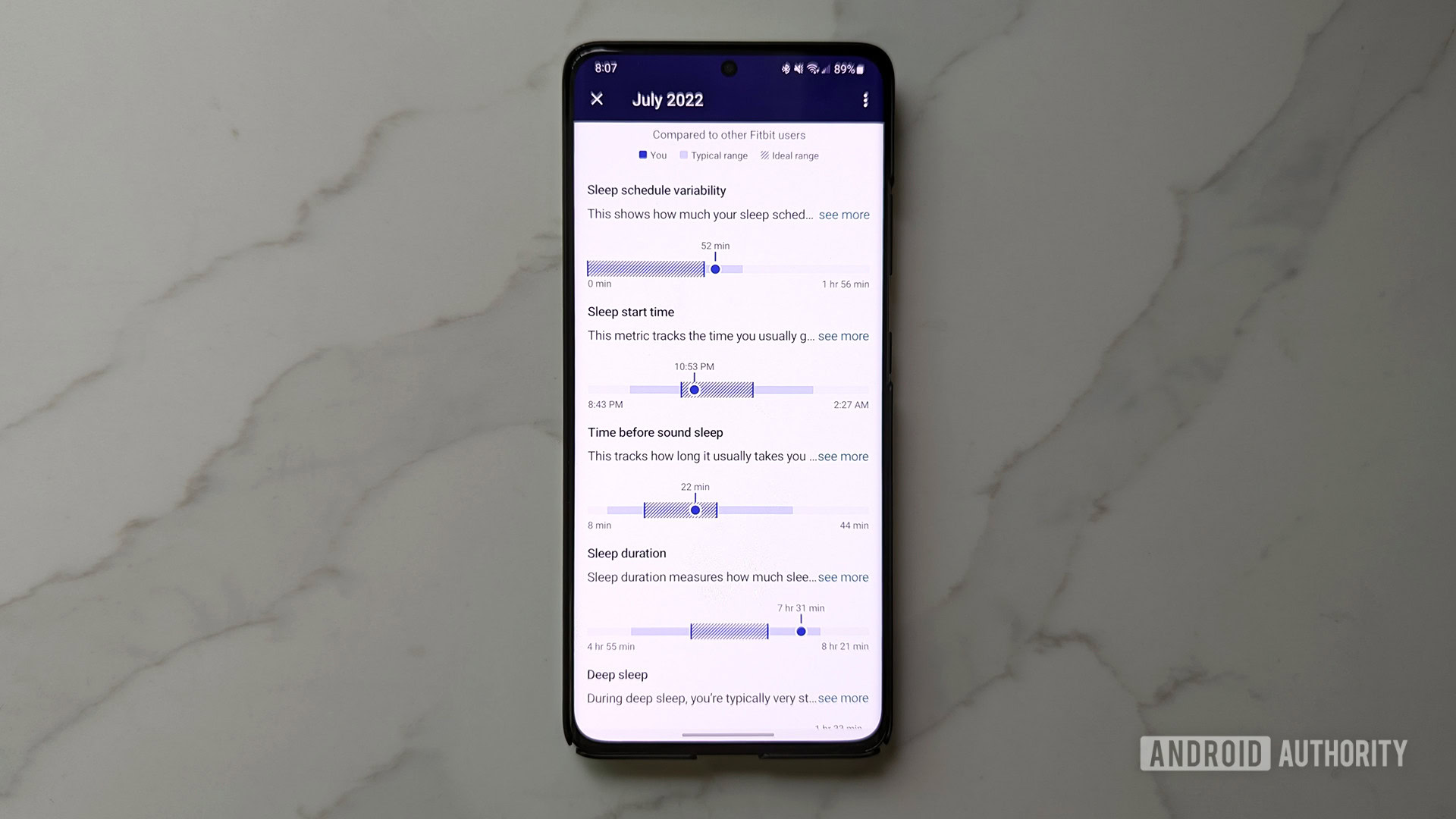Affiliate links on Android Authority may earn us a commission. Learn more.
How Fitbit is changing the way we think about sleep
Published onAugust 21, 2022

In the middle of 2022, Fitbit rolled out a new feature for its suite of sleep tracking tools included with Fitbit Premium. Known as Sleep Profile, this program monitors your sleep over an entire month. It then analyzes that data to produce what it calls a sleep phenotype — one of six types of sleep habits. Fitbit playfully represents the six phenotypes as animals: the Bear, Dolphin, Giraffe, Hedgehog, Parrot, and Tortoise. Each month, the Fitbit app assigns you one of these animals and explains how your sleep habits led to that selection.
When it rolled out, it appeared to be a fun addition to an already industry-leading suite of consumer sleep analysis tools. In fact, many Fitbit users may have written it off as being a bit of fluff. However, not only is it a useful tool for monitoring your sleep habits but it’s also a huge leap forward for sleep research in general.
I recently sat down with Karla Gleichauf, a senior research scientist at Fitbit, to discuss Sleep Profile. We talked about how Sleep Profile came to be, why it’s more important than you might think, and what it could spell for the future of sleep analysis.
Sleep Profile: How does it work?

All current Fitbit trackers and watches can obtain mountains of data when you sleep. In the case of the most recent flagship wearable from Fitbit — the Fitbit Sense — it can track your heart rate, SpO2 readings, skin temperature, and even if and when you snore. It can also track when you go to sleep, when you wake up, and all the little starts and stops of your sleep throughout the night.
Since 2019, the Fitbit app has examined all this data and given you a daily sleep score. This is helpful, certainly, but there was no tool to see how well you were sleeping over longer periods of time. Are you always oversleeping on Sundays? Do you constantly wake up during the week but sleep soundly during the weekend? Questions like these had to be answered by the user going through their daily sleep data and making their own judgments.
Fitbit assigns you an animal to give you an idea of what kind of sleeper you are.
Since Fitbit initially rolled out sleep tracking, Karla Gleichauf and her team were already working on figuring out a way to take this responsibility away from the user and present sleep habits in a macro sense. The team took early inspiration from online quizzes — you know, like the ones from Buzzfeed that tell you which Harry Potter house you belong to. Working with five sleep research experts, Fitbit figured out a way to pull over 1,000 various attributes of sleepers down to just six sleeper phenotypes and create an algorithm that can assign these types to users.
What are Fitbit’s Sleep Profile phenotypes?
As mentioned, six animals represent the Sleep Profile phenotypes:
- Bear: Bears keep consistent sleep schedules, falling asleep around the same time each night and waking up reliably in the morning. They tend to get a high proportion of deep and REM sleep. Because of all this, Bears tend to nap infrequently.
- Dolphin: Dolphins tend to go to bed later than most and sleep for less time. Because of these irregularities, Dolphins tend to take frequent naps to catch up on the sleep they’ve missed.
- Giraffe: Giraffes enter quality sleep (deep and REM) quicker, but go to bed later and wake up earlier than most. In other words, they are very efficient sleepers but still don’t get quite enough sound sleep.
- Hedgehog: Like the Giraffe, Hedgehogs go to sleep late and wake early. However, they tend to be light sleepers, so get less deep and REM sleep as a result.
- Parrot: Parrots are very consistent about bedtime. They don’t sleep too early or too late. They tend to sleep deep but experience less REM sleep than others. This is due to many brief wake-ups throughout the night.
- Tortoise: Tortoises tend to fall asleep at different times each night, but more often than not are headed to bed early. This means they tend to spend more time in bed than the average person. They get more sleep, but it takes them longer to get sound sleep. Because of this, a Tortoise might still need a nap even after spending all night in bed.
You might be thinking about which animal best describes your own sleep habits. Myself, I figured I was a Bear since I stick to a reliable sleep schedule and have been frequently told that I’m a very deep sleeper. However, for two months in a row, I have been phenotyped as a Parrot. Apparently, I wake up very frequently throughout the night, although sometimes so briefly that I don’t remember it.
James Park, Fitbit’s CEO, discovered he is a Dolphin. Fitbit has also discovered that the Giraffe profile is the most common among users, meaning most Fitbit wearers are getting good quality sleep quickly but aren’t getting enough of it.
Most Fitbit wearers are getting good quality sleep but not enough of it.
Most importantly, though, your animal phenotype is not rigid. After all, your sleep habits might be smooth and steady this month, but next month be wildly erratic for any number of reasons: travel, family visiting, pregnancy, etc. So not only is Fitbit sleep tracking keeping an eye on your sleep habits daily and now monthly, but you can also see a top-down view of your sleep over an entire year.
It might not seem like it, but this could wildly change sleep research as a whole.
Fitbit sleep tracking: Unprecedented data

There are three major problems with traditional sleep research. When I say “traditional,” I mean obtaining a bunch of monitoring gear from researchers and then sleeping while they tally data.
The first problem is that it is difficult — not to mention expensive — to consistently monitor a patient’s sleep many nights in a row like this. People only have so much time they’re willing to donate to research, so you tend to get a few nights from a patient before they move on. This leads to the second problem, which is a huge variety of sleepers. One or two nights of data from Person A mixed with one night of data from Person B isn’t nearly as helpful as one month of data from one person.
Fitbit has access to sleep data that sleep researchers can only dream of.
This leads to the third problem, which is putting people in an unfamiliar environment. Even if you conduct research from a person’s home, they still need to wear unfamiliar equipment, and they are aware that they are being monitored, which could affect their sleep habits. Combined, this all makes sleep research very challenging.
Check out: How to get started with Fitbit
Fitbit, however, doesn’t need to deal with these issues. People can sleep under normal circumstances with just a device on their wrists. You can get a ton of data consistently over the weeks and months, assuming the user wears their tracker consistently. And Fitbit has millions of users all around the globe. This is like a metaphorical firehose of sleep data pouring into Fitbit each day — data that traditional sleep researchers have never had access to.
This is why Sleep Profile isn’t just a fun novelty involving cartoon animals. In some ways, this is revolutionary information about human sleep habits of a magnitude we’ve never seen before.
Do you use a sleep tracker?
But what can we do with all this data?

Fitbit has taken the first step with Sleep Profile. Gleichauf explained to me that even the very idea of phenotyping sleep habits is relatively new. She said the sleep research community has always hypothesized that there are different types of sleepers but didn’t have enough data to figure out how many, how they should be categorized, etc. Fitbit’s Sleep Profile is essentially the first time phenotyping on this scale has been possible.
Of course, phenotyping sleepers is helpful, but it doesn’t answer the really big questions about sleep. For example, there is evidence that getting fewer than six hours of sleep every night is bad — it can increase the odds of cancer and even death for people with Type 2 diabetes, for example. But if that’s the case, what is “good” sleep? How much should you be sleeping each night? What can you do to make your sleep better? Is napping good or bad? Is it OK if I’m a Tortoise, or should I be a Bear? How do I become a Bear? These are all questions we don’t know the definitive answer to.
We now have a ton of sleep data. Can we finally answer the big questions about sleep?
Gleichauf and Fitbit want to answer these questions. Gleichauf’s hope is that someday in the future, the Fitbit app will be able to actively suggest changes you can make to enhance your sleep. She also hopes Fitbit will be able to back up those suggestions with data and research peer-reviewed by doctors and researchers.
Remember that this is essentially uncharted territory. REM sleep wasn’t discovered until the 1950s and sleep research as a whole didn’t really get serious until the middle of the 20th century. In other words, we have a lot of catching up to do when it comes to understanding why we sleep, the benefits of sleep, and how to be healthy with your sleep habits.
After all, we’re all sleeping about a third of our lives. Shouldn’t we work to understand that as much as possible?